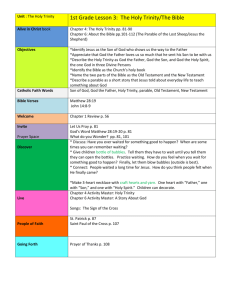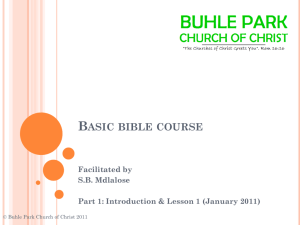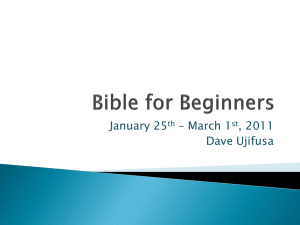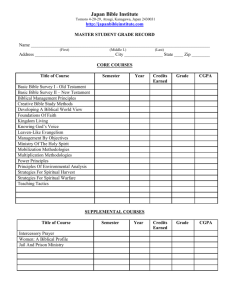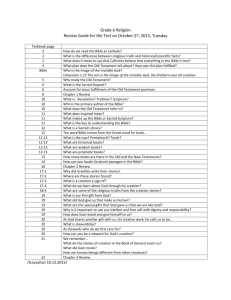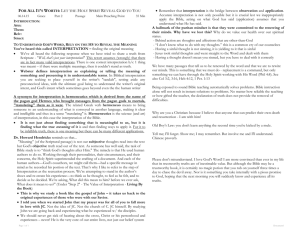Introduction To Holy Bible
advertisement
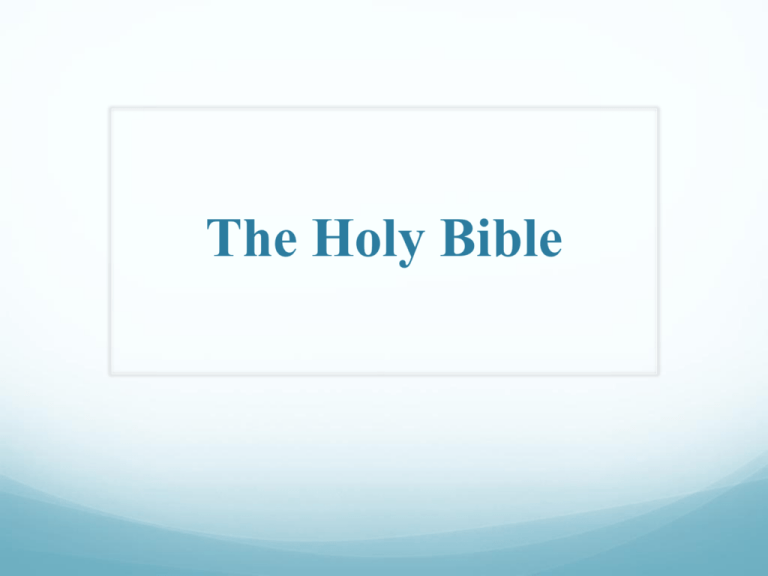
The Holy Bible Introduction to the Holy Bible Introduction to the Holy Bible General Comments on the Holy Bible: 1. The Holy Book consists of all Books inspired by God, related to the creation of the world and its salvation, the history of the dealings of God with His people, prophecies of the end time, and didactic (doctrinal and moral) commandments that suit mankind over the different period of times. 2. ‘The Holy Bible’ or ‘the Holy Book’ is also called ‘the Scriptures’ and ‘the word of God:’ “And He opened their understanding, that they might comprehend the Scriptures” (Luke 24:44) “For the word of God is living and powerful, and sharper than any… Introduction to the Holy Bible two-edged sword, piercing even to the division of soul and spirit, and of joints and marrow, and is a discerner of the thoughts and intents of the heart” (Hebrews 4:12) 3. The number of authors of the Books of the Bible is forty and they came from all kind of classes of people, from shepherd to fisherman to leader to tax collector to prophet, to the king and to the politician. All authors were Jews, except for Luke who was a Gentile from Antioch in Syria. 4. It was written over a period of 1,600 years. 5. Even though the Books of the Bible were written in different time periods, from various places and with different text styles, they have in common the same composition based on one divine inspiration. This is… Introduction to the Holy Bible in spite of the diversity necessitated by the circumstances occurring at the time of writing. 6. Divergent literary styles are in the Scriptures, from prose, to poetry, to history, to story, to wisdom, to literature, to prophecy, to education, to warning, to philosophy and to proverbs. 7. In spite of the old ages where the Books were written in, they are still relevant for past, present, and future times. The more civilization advances, the more the Holy Book importance increases. 8. The Holy Book is the source of Christian faith. Consequent to the divine inspiration of the Holy Book is its inerrancy and its inclusion of all that is required for faith and spiritual life. It is the heavenly bread for all true Christians, and his guide in life and in death. Introduction to the Holy Bible 9. The Holy Book is divided into two sections: the Old Testament and the New Testament. 10. The number of Books in the Bible is sixty-six. Thirty-nine of them are in the Old Testament. These do not include Deuterocanonical Books that were omitted by the Protestants. Twenty-seven Books are in the New Testament. 11. The Apostle Paul wrote the largest number of Books, which is 14 Epistles. 12. The longest Books are the Book of Psalm in the Old Testament, which consists of 151 chapters, and the Book of Acts in the New Testament, which consists of 28 chapters. 13. The shortest Books are the Book of Obadiah in the Old Testament,… Introduction to the Holy Bible which consists of one chapter (21 verses), and the 2nd of St. John in the New Testament, which consists of one chapter (13 verses). Accordingly, it is the shortest Book in the Bible. 14. The Holy Bible encompasses around the Lord Jesus Christ and its main theme is ‘The Lord Jesus Christ the Savior of the World.’ 15. The Bible is like a flower that was a bud in the Old Testament, opening very slowly. In the New Testament, the flower fully opened showing beautiful colors and carrying sweet aroma. 16. The message about ‘the Messiah’ is slowly declared in the Old Testament, and it is fully revealed in the New Testament. 17. The beauty and value of this message in my personal life is that I, through God’s grace, exert to explore it, keep it, live with it and enjoy it: Introduction to the Holy Bible “You search the Scriptures, for in them you think you have eternal life; and these are they which testify of Me” (John 5:39) 18. The Lord Jesus Christ then is the chief cornerstone that relates the Old Testament with the New Testament: Introduction to the Holy Bible The Old Testament The Need for a Savior The New Testament The Savior Came and Will Come Again 1. The Pentateuch - The Law or Torah. - Fallen Mankind need a Savior from the curse of the Law. 1. The Four Gospels - The Law of the New Testament. - The Coming of the Savior the life-giver. 2. The Historical Books - History of God’s work with His People in the New Land and Captivity. - Getting to know the Coming Christ. 2. The Book of Acts - History of God’s work in the believers through His Holy Spirit. - The Lord Christ present in His Church. 3. The Poetic Books - The Need for the divine wisdom. - Practical doctrine to live with God. 3. The Epistles - True wisdom is to unite with Christ. - Practical doctrine to live in Christ through the Holy Spirit. 4. The Prophets - Precise prophesies about the Coming Messiah. - Prophets calling for repentance and asserting the need of His Coming. 4. Book of Revelation - Christ’s Second Coming and Eternal Life. - Encourages the believers to strive in the Lord, awaiting His Second Coming.


